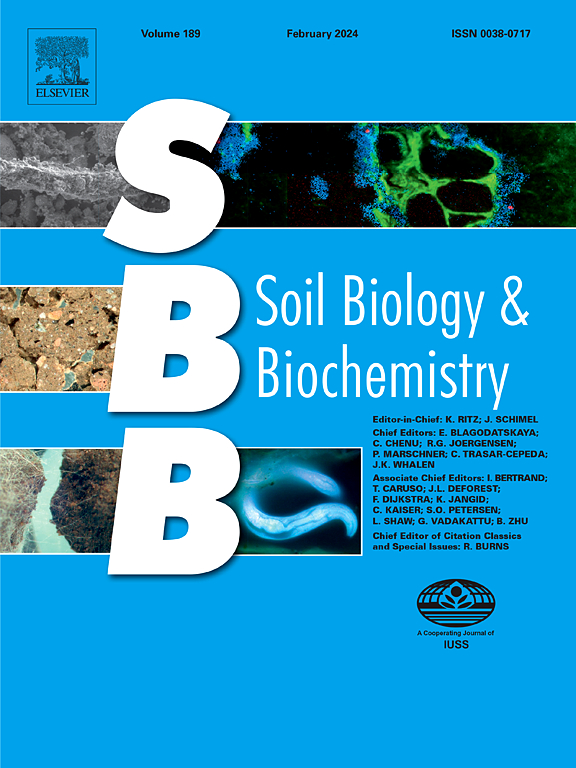在非目标土壤和受植物影响的土壤中,土壤微生物群落结构和功能对氮富集的响应相似
IF 9.8
1区 农林科学
Q1 SOIL SCIENCE
引用次数: 0
摘要
植物依靠土壤微生物,特别是根际微生物来获取资源;然而,这些关系在干扰后发生改变,包括营养物质的富集。随着条件的变化,植物也通过重新定向分泌物来促进资源可用性的变化,但这种能力因物种身份而异。在本研究中,我们比较了施用氮肥(10 g-1 m-2)后一般植物下(H1)土壤群落的活性和组成,以及石缝蒿和荆芥(H2)土壤群落的活性和组成。我们预计,在对照条件下,微生物结构和功能反映的是根际相对富碳的环境,而施氮会使微生物群落组成和活性均匀化。虽然有几个变量对施肥或植物投入有反应,但我们发现样本位置和施肥之间的相互作用很少,这表明支持我们的假设。在比较块状土壤和植物间施肥效应的H1中,施肥增加了受植物影响土壤中β-1,4- n乙酰氨基葡萄糖酶的活性,表明与未施肥的植物根际相比,这些根际微生物减少了植物挥发物的活性碳。此外,在未施肥的非目标条件下发现的革兰氏阳性细菌与革兰氏阴性细菌的比例较高,这表明与其他条件相比,大块土壤的低氮低碳资源组合是唯一的压力。对于H2,对比两种植物在受精后的差异,我们发现在未受精的凤尾草根际,PLFA代谢应激指数降低,这表明更多的不稳定碳流入这些微生物。不同施肥条件下,山楂的相对盖度保持不变,表明资源再分配具有灵活性,而凤尾花的相对盖度则有所下降。这些植物-土壤相互作用发生在小块土壤中,但规模足以影响区域和全球的生物地球化学循环和生物多样性。尽管我们发现对我们的假设的支持有限,但我们继续研究这些过程以了解环境的变化是至关重要的。本文章由计算机程序翻译,如有差异,请以英文原文为准。
Soil microbial community structure and function in non-target and plant-influenced soils respond similarly to nitrogen enrichment
Plants rely on soil microbes, particularly those in their rhizosphere to access resources; however, these relationships are altered following disturbance, including nutrient enrichment. Plants also contribute to variation in resource availability by redirecting exudates as conditions change, but the ability to do this varies with species identity. In this study we compared the activity and composition of soil communities following nitrogen fertilization (10 g−1 m−2) beneath plants in general (H1) and between Ratibida pinnata and Schizachyrium scoparium specifically (H2). We expected that the microbial structure and function would reflect the relatively C-rich environment of root rhizospheres under control conditions, but that N fertilization would homogenize microbial community composition and activity. Although several variables responded to either fertilization or plant input, we found few interactions between sample location and fertilization, which would indicate support for our hypotheses. For H1, which compared fertilization effects between bulk soil and plants generally, fertilization increased β-1,4-N acetylglucosaminidase activity in the plant-influenced soils, indicating that these rhizosphere microbes had reduced availability of labile carbon plant exudates compared with unfertilized plant rhizospheres. Furthermore, the higher ratio of Gram-positive to Gram-negative bacteria found in the unfertilized non-target condition suggests that the combination of low nitrogen and carbon resources of the bulk soil was uniquely stressful compared to other conditions. For H2, which compared the two plant species following fertilization, we found a reduced PLFA Metabolic Stress Index in the unfertilized rhizosphere of R. pinnata, which indicates a greater influx of labile carbon to these microbes. R. pinnata also maintained its relative cover with fertilization, indicating flexibility in reallocating resources, while relative cover of S. scoparium decreased. These plant-soil interactions occur within small volumes of soil yet scale to affect regional and global biogeochemical cycles and biodiversity. Although we found limited support for our hypotheses it is critical that we continue to study these processes to understand changes to our environment.
求助全文
通过发布文献求助,成功后即可免费获取论文全文。
去求助
来源期刊

Soil Biology & Biochemistry
农林科学-土壤科学
CiteScore
16.90
自引率
9.30%
发文量
312
审稿时长
49 days
期刊介绍:
Soil Biology & Biochemistry publishes original research articles of international significance focusing on biological processes in soil and their applications to soil and environmental quality. Major topics include the ecology and biochemical processes of soil organisms, their effects on the environment, and interactions with plants. The journal also welcomes state-of-the-art reviews and discussions on contemporary research in soil biology and biochemistry.
 求助内容:
求助内容: 应助结果提醒方式:
应助结果提醒方式:


